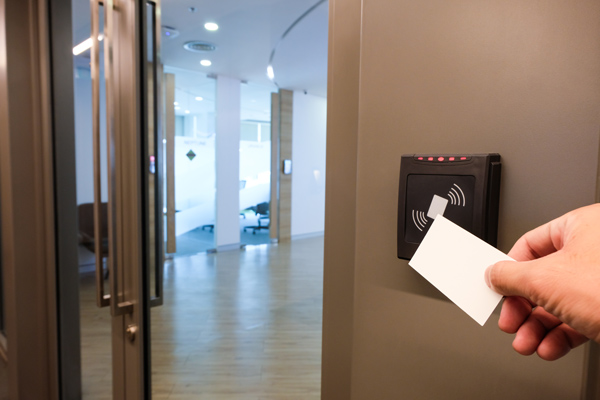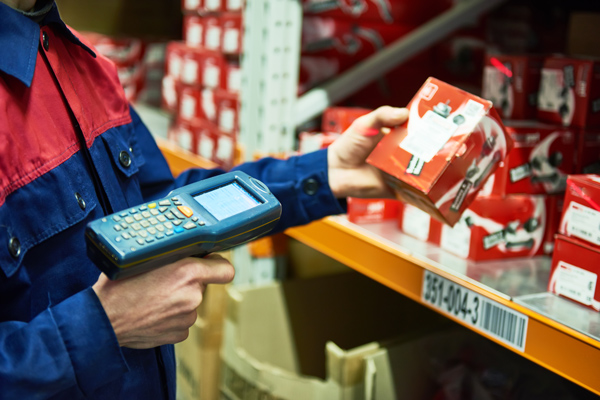Overview
- RFID tags and mobile barcoding both collect data that can be retrieved with a scanner.
- RFID tags hold more data but are more expensive. Barcodes hold less data but are less expensive and more universal.
- When evaluating RFID vs barcoding, consider use, cost and type of inventory.

With the RFID market share expected to grow 7.7% by 2023, many companies are considering if RFID technology is the right fit for their operations. Perhaps you have already implemented mobile barcoding or you are trying to decide between the two.
You might be wondering how RFID technology and mobile barcoding differ in their use and which one is the better fit to improve inventory management in your facility. This article will examine some of the similarities and differences between the two before exploring scenarios where RFID or mobile barcoding may be the optimal choice.
Here’s what you need to know:
What is RFID?
Radio Frequency Identification Tags, more commonly known as RFID tags, use microchip technology to store data. When placed near an RFID reader, the RFID tag’s antenna receives electromagnetic energy from the reader. Then, the tag sends radio waves back to the reader. Once received, the reader interprets the frequencies for the encoded data.
How Are RFID and Mobile Barcoding Similar?
Both RFID and mobile barcoding are ways to automatically collect data. Both RFID and mobile barcoding can collect data using handheld scanners, though not the same types. Because of this, they are both appropriate means of tracking inventory, albeit in different contexts.
WATCH VIDEO: Toyota Successfully Combines RFID & Mobile Barcoding –
How Are RFID and Mobile Barcoding Different?

While both RFID and barcodes can collect and store data, RFID can store greater volumes and more types of that data. And while barcodes have to be scanned one at a time to collect that data, RFID tags can be scanned all at once to retrieve that data faster. Plus, since RFID is a “near field” technology, the scanner only needs to be in range of the RFID tags while barcodes have to be within line of sight of the barcode reader’s main sensor.
Imagine going to a store and purchasing multiple items. Normally, you have to unload the items out of the shopping cart, hand them to the cashier, and then the cashier scans each barcode separately. With RFID technology, you could simply walk to a designated checkout area and the RFID scanner would scan everything in the cart to give you the total – no unloading or scanning separate barcodes.
So that makes RFID tags the better choice, right?
Not necessarily.
You may have read about RFID and its many benefits, concluding that RFID is the right solution without fully understanding potential complications or alternatives. Budget is often a factor here.
While RFID tags are powerful, they come with a higher price tag than a barcoding system.
Barcoding solutions tend to be much less expensive than RFID, making them more accessible for many operations. They also integrate more easily with other technology systems, such as industrial computers (PLCs), carousels and scales, for more versatile data collection.
Mobile barcoding has the added bonus of including enterprise mobility, so workers can better move around and scan as needed. Mobility adds technological support to social distancing modifications needed for COVID-19 safety by:
- Eliminating the need for workers to share potentially contaminated paperwork,
- Reducing touch and germ transfer from shared keyboards,
- Enabling remote messaging, free from unsafe proximity to co-workers, and
- Providing long-range scan capabilities up to 70 feet.
Among others.
Read More: How Mobile Barcoding Supports Social Distancing »
RFID vs Mobile Barcoding: Which One Should I Use?

It depends – there’s a time and a place for both technologies.
When to Use RFID
If you need to track high value assets or have extensive MRO needs, investing in the additional expense of RFID may make sense. RFID may also be the better choice if you need to store greater volumes or more types of data than a 1D or 2D barcode can support.
RFID is ideal for tracking high value, small part inventory such as sub-assembly parts. One of our customers, for example, is in the process of installing RFID portals near its cabinets that store these parts. This helps the company automatically and accurately track the movements of these parts as they are removed and replaced by engineers.
When to Use Mobile Barcoding
Barcoding is the more cost-effective method for tracking inventory. Barcode automation is universally accepted throughout the supply chain, making it the safer investment. Mobile barcoding adds the additional benefit of meeting today’s social distancing requirements while bolstering the smaller workforces from COVID-19.
RFID tags and mobile barcoding don’t have to be an either/or choice. Some materials, such as metal, can actually block an RFID tag’s signal, so a scanner can’t pick up the data. A construction company, for example, might have extensive asset management costs and want to invest in using RFID tags to track some of their inventory. However, for inventory that might interfere with the signal, such as thick I-beams, scanners may not be able to detect the signal. Barcodes can be used to fill this gap.
Conclusion
In short, both RFID tags and mobile barcoding have their place in the supply chain. While RFID tags can store greater amounts and more types of data, mobile barcoding is more cost-efficient and better-suited to support today’s post-pandemic modifications, such as social distancing.
If you are unsure about which choice is the best for your operation, or need help finding the best fit data collection solution, schedule a call with one of our expert consultants.






